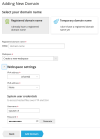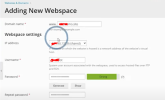Guys, I must apologize. To clarify: The question was whether on the "Web Admin" licence each domain that the licence owner adds is running under the same system user. My previous knowledge was: Yes, it does. When you guys said that this is different I went to ask tech staff and they responded that on the "Web Admin" licence indeed all domains that the user adds are using the system user.
But later yesterday I had set-up a test scenario for exactly that case and found something different, like
@vikK is showing in the screenshot above. So most obviously as tech leaders also were under the impression that all domains of a "Web Admin" licence are using the same sysuser there must have been some upgrade in the past that we missed.
The correct information is: Each domain that is added on a "Web Admin" licence is using a separate sysuser account. For that reason, malware that infects one domain cannot infiltrate another easily.
However, what is still true is that there is only one admin login by default, so if an attacker manages to login to that Plesk server, the attacker can access all domains.
@Dave W You are also right, but on the "Web Admin" licence, the user normally adds the domains directly from admin level. He does not see the "subscription" concept. On the bigger licences, with subscription concept, the user can also add several domains into the same subscription. In that case such domains are prone to migrated attacks from other domains in that subscription.
I hope this clarifies it all. I'll update my previous posts in this thread accordingly. If you have any more questions, I'll be more than happy to get the answers right for you. There have been several questions on the different licence types and I am more than willing to make sure that it is clear how it all works.


